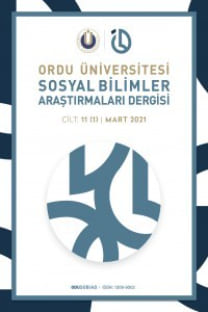MEDYA OKURYAZARLIĞININ DEĞERLENDİRİLMESİ: KONULAR, SORUNLAR VE OLASILIKLAR
Son yıllarda yeni iletişim teknolojilerinde gözlemlenen gelişmeler göz önüne alındığında, gerek geleneksel medya gerekse yeni medya hayatımızın neredeyse odağında yer almaktadır. Özellikle yeni medya kullanımının artması ile birlikte, içerik oluşturma da kolay bir hale gelmiştir. Bir içeriği kimin, ne amaçla yarattığı ve o içeriğin güvenilir olup olmadığı her zaman bilinemez. Dolayısıyla, okurların, izleyicilerin veya kullanıcıların, medya tarafından sunulan sınırsız görüntüleri, görüşleri ve yazıları nesnel ve eleştirel olarak değerlendirebilmeleri oldukça önemlidir. Bu çerçevede, bakımından medya okuryazarlığı eğitimi bu amaca hizmet edebilir. . Bu betimsel çalışmanın amacı, günümüzde, dijitalleşmenin artışı ile birlikte daha da çok gereksinim duyulan medya okuryazarlığı anlayış ve uygulamalarını ana noktalarıyla inceleyerek, medya okuryazarlığı eğitiminin hedefine ulaşabilmesi bakımından medya okuryazarlığı programında olması gereken özellikleri vurgulamaktır.
Anahtar Kelimeler:
Medya ve bilgi okuryazarlığı, Medya okuryazarlığı eğitimi, Eleştirel anlayış, Aktiflik, Kullanıcı
ASSESSING MEDIA LITERACY: ISSUES, PROBLEMS AND POSSIBILITIES
Considering the developments observed in new communication technologies in recent years, both traditional media and new media are at the center of our lives. Especially with the increasing use of new media, content creation has become easier. It is not always known who created a content for what purpose and whether it was reliable. Therefore, it is important that readers, viewers or users can objectively and critically evaluate unlimited images, views and writings presented by the media. In this framework, media literacy education can serve the purpose. The only way to make these assessments is through media literacy education. The aim of this descriptive study is to examine main understandings and practices of media literacy, which is needed more with increase in digitilization today , and to emphasize the issues that should be included by the media literacy program in order to achieve the goal of media literacy education.
Keywords:
Media and information literacy, Media literacy education, Critical understanding, Activity, User,
___
- Asrak Hasdemir, T. (2016). “Yeni Medya Okuryazarlığı ve Türkiye: Moy 2014 Hakkında Bir Değerlendirme” Yeni Medya Çalışmaları II. Ulusal Kongresi Kongre Kitabı. 80-101. https://ekitap.alternatifbilisim.org/files/yeni_medya_ calismalari-2_kongre_kitabi.pdf (Erişim Tarihi: 25.03.2018)Asrak Hasdemir, T. ve Uyar, M. (2019). Representation of the New in the Traditional: New Media, Children’s Magazines and Digital Literacy. (Der. Green L., Holloway D., Stevenson K. Ve Jaunzems K.), Digitising Early Childhood içinde. (s. 74-103). UK: Cambridge Scholars Publishing.Brown, J. A. (1998). “Media Literacy Perspectives”, Journal of Communication, 48(1), 44-57.
- Buckingham, D.; Fraser, P. ve Mayman, N. (1990). Stepping in to the Void: Beginning Classroom Research in Media Education, (Der. Buckingham D.), Watching Media Learning içinde. (s. 19-59). London: Falmer.
- Buckingham, D. (2001). “Media Education, A Global Strategy for Development: A Policy Paper Prepared for UNESCO”, Sector of Communication and Information, UNESCO.
- Buckingham, David; Banaji, Shaku; Burn, Andrew; Carr, Diane; Cranmer, Sue ve Willett, Rebekah (2005). The Media Literacy of Children and Young People: A review of the research literature on behalf of Ofcom. London: Ofcom.
- Buckingham, David (2007). “Digital Media Litearacies: Rethinking Media Education in the Age of the Internet”, Research in Comparative and International Education, 2(1), 43-55.
- Carlsson, U. (2019). “Media and Information Literacy: Field of Knowledge, Concepts and History”, içinde (ed.Ulla Carlsson) Understanding Media and Information Literacy (MIL) in the Digital Age: A Question of Democracy”, Göteborg: UNESCO. Christ, W. G. ve Potter, W. J. (1998). “Media Literacy, Media Education, and the Academy”, Journal of Communication, 48(1), 5-15.
- Grizzle, A. ve Calvo, M. C. T. (2013). Media and Information Literacy: Policy & Strategy Guidelines, Paris: UNESCO.
- Hobbs, R. (1998). “The Seven Great Debates in the Media Literacy Movement”, Journal of Communication, 48(1), 16-32Hobbs, R. (2010). Digital and Media Literacy: A Plan of Action. Washington, DC: The Aspen Institute. https://www.knightfoundation.org/media/uploads/publication_pdfs/Digital_and_Media_Literacy_A_Plan_of_Action.pdf (Erişim Tarihi: 25.10.2019) Khan, A. W. (2006). Preface. (Der. Frau-Meigs D.), Media Education: A Kit for Teachers, Students, Parents and Professionals içinde. (s. 5). Paris: UNESCO.
- Kesseler, A. ve Bergs, A. (2003). Literacy and the new media: Vita brevis, lingua brevis. (Der. Aitchison J. Ve Lewis D.), New Media Language içinde. (s. 75-84). London: Routledge,
- Livingstone, S. ve Bober, M. (2005). UK Children Go Online: Final report of key Project findings. 6. London School of Economics and Political Science, London, UK.
- Livingstone, S.; Couvering V., E.; Thumim, N. (2005). “Adult Media Literacy: A review of the research literature on behalf of Ofcom”. http://dera.ioe.ac.uk/5283/1/aml.pdf (Erişim Tarihi:16.12.2016)
- NAMLE (2016). MLE &Common Core Standarts. https://namle.net/publications/mle-common-core-standards/ (Erişim Tarihi: 29.12.2016)
- Ofcom (2004). Ofcom’s strategy and priorities for promoting media literacy. London: Ofcom.
- Ofcom (2016). About Media Literacy.https://www.ofcom.org.uk/research-and-data/media-literacy-research/media-literacy (Erişim Tarihi:20.12.2016)
- Potter, W. J. (2010). “The State of Media Literacy”, Journal of Broadcasting & Electronic Media, 54(4), 675-696.
- Türkoğlu, N. (2006). Konferans Çağrısından Kitaba: “Medya Okuryazarlığı”. (Der. Türkoğlu N.), Medya Okuryazarlığı içinde. (s. i). https://www.academia.edu/277963/MEDYA_OKURYAZARLI%C4%9EI (Erişim Tarihi: 11.11.2019) UNESCO (2007). Media and Information Literacy. https://iite.unesco.org/mil/ (Erişim tarihi:15.10.2019) UNESCO (2007). PARIS AGENDA OR 12 RECOMME DATIONS FOR MEDIA EDUCATION. (http://www.diplomatie.gouv.fr/fr/IMG/pdf/Parisagendafin_en.pdf (Erişim Tarihi: 07.12.2016)
- UNESCO (2013). Media and Information Literacy for Knowledge Societies. Moscow: Interregional Library Cooperation Centre. Wartella, E., O’Keefe B., Scantlin R., (2000). “Children and Interactive Media: A Compendium of Current Research and Directions for the Future, New York Markle Foundation, 2000”. http://www.markle.org/general-markle/children-and-interactive-media-compendium-current-research-and-directions-future (Erişim Tarihi:29.07.2016)
- Wartella, Ellen, Lee, June H. ve Caplovitz, Allison G. (2002). “Children and Interactive Media: Research Compendium Update”. https://www.researchgate.net/publication/237246591_Children_and_Interactive_Media_Research_Compendium_Update (Erişim tarihi: 29.07.2016)
- ISSN: 1309-9302
- Yayın Aralığı: Yılda 3 Sayı
- Başlangıç: 2010
- Yayıncı: -
Sayıdaki Diğer Makaleler
Türkiye’de Ulusal Yayın Yapan Televizyon Kanallarının Yayın Akışlarının Türsel Bazda Analizi
Seda SÜNBÜL OLGUNDENİZ, Pınar ÖZGÖKBEL BİLİS
Akademik Doğa Kampına Yönelik Öğrenci Görüşleri
Elif ÇOBANOĞLU, Mahir YERLİKAYA, Aslı YERLİKAYA
Çevre Vergilerinin CO2 Emisyonu Üzerindeki Etkisi Üzerine Bir Uygulama
Efe Can KILINÇ, Hande ALTIPARMAK
Dijital Boyamanın Evriminde Sanal Gerçeklik Boyutu
Kassitler ve Hititler Arasında İlişkiler
Niyazi GÜMÜŞ, Ebru ONURLUBAŞ, Şükran KARACA
Hz. Ömer’in Ağabeyi Zeyd b. Hattâb’ın Hayatı Üzerine Bir Değerlendirme
